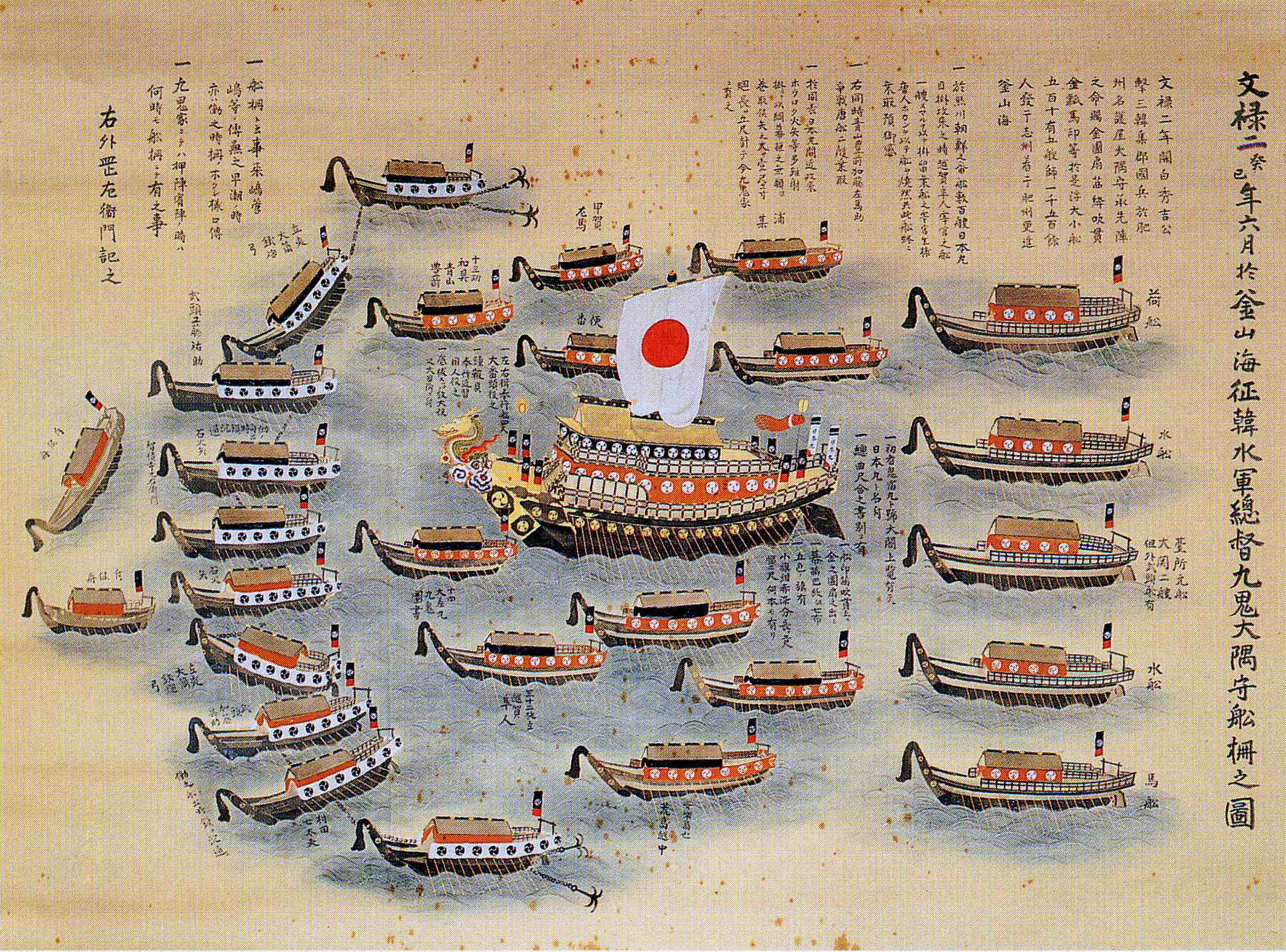Kuki Yoshitaka on:
[Wikipedia]
[Google]
[Amazon]
(1542 – November 17, 1600) was a naval commander during Japan's Sengoku Period, under

Ninpo.org
Accessed 28 Dec 2004
Oda Nobunaga
was a Japanese ''daimyō'' and one of the leading figures of the Sengoku period, Sengoku and Azuchi-Momoyama periods. He was the and regarded as the first "Great Unifier" of Japan. He is sometimes referred as the "Demon Daimyō" and "Demo ...
, and later, Toyotomi Hideyoshi
, otherwise known as and , was a Japanese samurai and ''daimyō'' (feudal lord) of the late Sengoku period, Sengoku and Azuchi-Momoyama periods and regarded as the second "Great Unifier" of Japan.Richard Holmes, The World Atlas of Warfare: ...
. He was also the ninth headmaster of the Kuki family's school of martial arts, Kukishin-ryū
, originally "Nine Gods Divine (from heaven) School" (also translated as "Nine Demon Divine (from heaven) School" by many modern groups having different lineages) is a Japanese martial arts, Japanese martial art allegedly founded in the 14th c ...
and thus a very skilled warrior.
Military life
In the 1570s, Kuki allied himself withOda Nobunaga
was a Japanese ''daimyō'' and one of the leading figures of the Sengoku period, Sengoku and Azuchi-Momoyama periods. He was the and regarded as the first "Great Unifier" of Japan. He is sometimes referred as the "Demon Daimyō" and "Demo ...
, and commanded his fleet, supporting land-based attacks on the Ikkō-ikki
were armed military leagues that formed in several regions of Japan in the 15th-16th centuries, composed entirely of members of the Jōdo Shinshū sect of Buddhism. In the early phases, these ''ikki'' leagues opposed the rule of local Shugo, go ...
at Ise Bay
is a bay located at the mouth of the Kiso Three Rivers between Mie prefecture, Mie and Aichi prefecture, Aichi Prefectures in Japan. Ise Bay has an average depth of and a maximum depth of . The mouth of the bay is and is connected to the small ...
.
In 1574, his aid ensured a victory for Nobunaga in his third attempt to attack the Nagashima fortress.
In 1575, Nobunaga allowed Yoshitaka to seize Shima Province
was a Provinces of Japan, province of Japan which consisted of a peninsula in the southeastern part of modern Mie Prefecture.Louis-Frédéric, Nussbaum, Louis-Frédéric. (2005). "''Shima''" in . Its abbreviated name was . Shima bordered on Ise ...
, forcing out other maritime clans, such the Mukai clan.
In 1576, he was defeated at Kizugawaguchi by the Mōri clan
The was a Japanese clan, Japanese samurai clan descended from Ōe no Hiromoto. Ōe no Hiromoto was descended from the Fujiwara clan. The family's most illustrious member, Mōri Motonari, greatly expanded the clan's power in Aki Province. Durin ...
fleet, but 1578 brought victory in the second Battle of Kizugawaguchi, in which Kuki used iron-armored ships, , to repel the arrows and musket balls of the opposing Mōri clan's ships.
In 1584, Yoshitaka along with Takigawa Kazumasu besieged Kanie castle, in Toyotomi Hideyoshi's campaign to consolidate his power over the lands held by the Oda clan in Owari province.
In 1587, he led Toyotomi Hideyoshi's fleet in a campaign in Kyūshū
is the third-largest island of Japan's four main islands and the most southerly of the four largest islands (i.e. excluding Okinawa and the other Ryukyu (''Nansei'') Islands). In the past, it has been known as , and . The historical regio ...
, alongside Konishi Yukinaga, Wakizaka Yasuharu and Katō Yoshiaki.
Three years later, along with Wakizaka Yasuharu and Kato Yoshiaki he went on to lead the Siege of Shimoda in the Odawara campaign 1590.
He continued in his role as commander of Hideyoshi's fleet, launching an invasion of Korea
Korea is a peninsular region in East Asia consisting of the Korean Peninsula, Jeju Island, and smaller islands. Since the end of World War II in 1945, it has been politically Division of Korea, divided at or near the 38th parallel north, 3 ...
in 1592 from his flagship ''Nipponmaru'', but he was severely defeated in the Battle of Myeongryang in 1597.

Death
In 1600, in theBattle of Sekigahara
The Battle of Sekigahara (Shinjitai: ; Kyūjitai: , Hepburn romanization: ''Sekigahara no Tatakai'') was an important battle in Japan which occurred on October 21, 1600 (Keichō 5, 15th day of the 9th month) in what is now Gifu Prefecture, ...
, Kuki Yoshitaka fought alongside the Ishida Mitsunari
was a Japanese samurai and military commander of the late Sengoku period of Japan. He is probably best remembered as the commander of the Western army in the Battle of Sekigahara following the Azuchi–Momoyama period of the 16th century. He ...
forces, while his son Kuki Moritaka joined the opposing force, under Tokugawa Ieyasu
Tokugawa Ieyasu (born Matsudaira Takechiyo; 31 January 1543 – 1 June 1616) was the founder and first ''shōgun'' of the Tokugawa shogunate of Japan, which ruled from 1603 until the Meiji Restoration in 1868. He was the third of the three "Gr ...
.
Following Tokugawa's victory, his son successfully guaranteed Yoshitaka's safety from Ieyasu. In a turn of fate, Yoshitaka committed seppuku
, also known as , is a form of Japanese ritualistic suicide by disembowelment. It was originally reserved for samurai in their code of honor, but was also practiced by other Japanese people during the Shōwa era (particularly officers near ...
before the news from Moritaka reached him.
See also
* Murakami Takeyoshi *Ohama Kagetaka
was a Japanese pirate during the latter part of the Sengoku period and the Azuchi–Momoyama period of Japan. He operated in the Shima Province area (now part of Mie Prefecture), and later commanded naval forces for both Takeda Shingen and Toku ...
References
*Ron, Roy (1999–2004). 'Genbukan Tokyo Shibu: Kuki Yoshitaka'Ninpo.org
Accessed 28 Dec 2004
Further reading
{{DEFAULTSORT:Kuki, Yoshitaka Samurai 1542 births 1600 deaths Oda retainers People of the Sengoku period 16th-century Japanese people